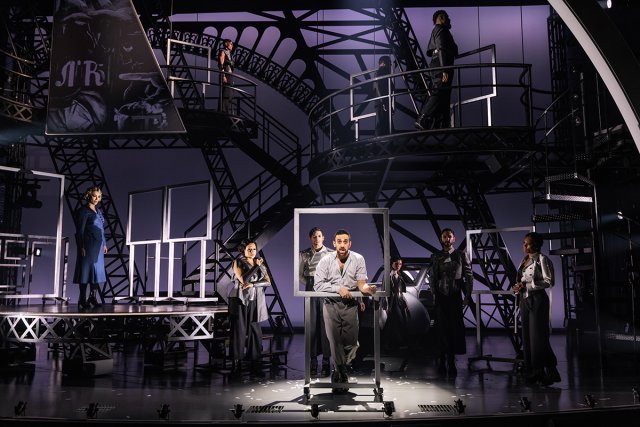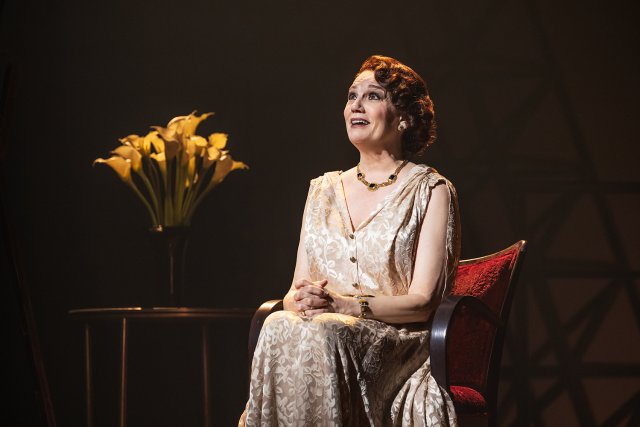Lempicka: The Bi-Sexual Baroness with a Brush
At New York’s Longacre Theater
By: Jessica Robinson - Apr 17, 2024
Lempicka has all of the elements for an uplifting musical, except for the uplift. Loosely based on the life of Tamara de Lempicka, the glamourus and self-mythologizing woman known for her Art Deco paintings, this musical should have been compelling. It isn’t.
Instead, it guides the audience on a journey through history with all the excitement of reading an encyclopedia.
The play unfolds with Lempicka, (portrayed by Eden Espinosa) in a moment of introspection. It is 1975 and she is an “old, eccentric bat” sitting on a park bench in Los Angeles, with zero cares about being yesterday’s news:
Do you know who I am?
an old woman who doesn’t give a damn
that history has passed her by
History’s a bitch
but so am I
The story then backtracks to show us how she ended up on a park bench.
Suddenly we are in St Petersberg, 1917, where we meet the young Lemipicka, her husband, Tadeusz, (Andrew Samonsky) a prominent Polish lawyer, and their daughter, Kizette, (Zoe Glick), who, by the way, never appears to grow up through the six decades this play takes us through.
The seemingly happy family is enjoying a carefree, privileged life, that is, until their life is interrupted by the Russian Revolution and Tadeusz is jailed by the Bolsheviks.
In order to free him, Tamara prostitutes herself. Once Tadeusz is released from prison, the family immigrates to Paris, where the story unfolds like a plain baguette in a city of croissants.
Arriving broke in the City of Lights, Lempicka quickly (too quickly) paints her way up the ladder with her Art Deco, highly sexualized, nudes and portraits of the rich and titled. Soon she meets, Rafaela (Amber Iman), a nightclub singer and prostitute who becomes her lover and muse.
The compressed plot becomes a mishmash of history, distilled to spoon-feed the audience bites that are not necessarily tasty. Instead of a celebration of a woman as idiosyncratic as the real Lempicka, a woman who painted her way from rags to riches, this Lempicka is lackluster and pedestrian.
While the authors tell us that the play is “inspired” by the artist’s personal and political life, unfortunately, all of the “real-life” characters are so hastily established and sketchily drawn, that what we’re left with is a lack of realism and emotional vulnerability. All the characters in this play are like wooden sticks, there is no depth to any of them.
And it doesn’t help that the writers take a ton of liberties with Lempicka’s life. For instance, the French Cabaret star and artist, Suzy Solidar (Natalie Joy Johnson) is portrayed as the owner of “a sumptuous, lesbian, Art Deco club” where the ladies wear tuxedos and elegant gowns. Though Solidar was indeed a lesbian, she never owned a gay club.
Additionally, Lempicka’s real art teachers in Paris were Andre Lhote and Maurice Denis, not a made-up Filippo Marinetti, the father of Futurism. While Lempicka did know Marinetti, he was not her teacher. This kind of shape-shifting turns what purports to be a play about real people into fiction. Weirdly, the made-up, implausible, Marinetti (George Abud) is the central figure in a messy walk through of the changing artistic movements of the era: Impressionism, Cubism, Futurism.
The fact that this story lacks the high recognition factor of a bio musical like “Evita” (most of the audience has probably never heard of Lempicka), suggests that the book and music should compensate. They don’t.
The music, with lyrics by Carson Kreitzer, music by Matt Gould, and book by both, fails to deliver a memorable tune, except for one, standout scene occurring in the second act of this nearly three-hour production.
In this scene, Lempicka’s patron, the Baroness, played by Tony-winning actress and singer, Beth Leavel, visits her studio to commission her portrait. She is dying of cancer and wants to give her husband, the Baron, a lasting memory. While sitting for her portrait, Leavel sings “Just This Way”:
“I’d like him to remember me
just this way
how the light comes in
unhurried
as if it will always be
this sunny April day”
Leavel’s beautiful voice delivers the only moment in the play with an iota of emotion.
While the music overall is mundane, the eye-catching, Art Deco sets, designed by Riccardo Hernandez, inject a much-needed dose of vitality. Comprising sinuous curves, bold angles, mechanical flourishes, and the iconic Eiffel Tower (don’t roll your eyes just yet), these sets strive to breathe life into the clichéd lyrics. But with songs like “Plan and Design” to describe what painting is, and “Woman Is” to tell us what a woman is, even the striking sets cannot compensate for the silly lyrics and tuneless tunes.
Backtracking to the beginning of this review, to answer the question: how did this show’s Lempicka end up an “old bitch” on a park bench? The short answer is, she divorced her husband, Tadeusz, married the Count (the one who was married to the dying Countess….and this part is true), WW11 broke out, the goose-stepping Nazis invaded Paris, the Count and Lempicka-- who were both Jewish--- fled to Los Angeles, where we find her on the park bench.
In life, Tamara de Lempicka was a bisexual who lived, and thrived, in Paris through the years between the wars, a place of decadent living and shifting morals. She was known for her relentless work ethic, pausing her marathon painting sessions only for such necessities as champagne, massages and amorous interludes. Her larger-than-life persona epitomized the era’s bold, bohemian spirit.
Yet, this Lempicka fails in every way to capture even a fraction of her fiery essence.
Lempicka at New York’s Longacre Theater through September 8
Photos by Matthew Murphy and Evan Zimmerman



